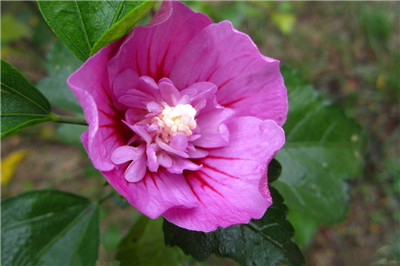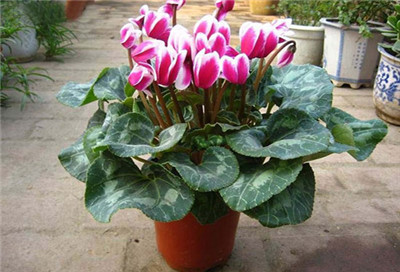Propagation, cultivation and Management of Dahlia (Dahlia)
Dahlia (Dahlia) is native to Mexico. Mexicans regard it as a symbol of generosity and richness, so they respect it as the national flower. At present, it has been planted in most countries in the world, and new varieties have been selected from time to time. According to statistics, there are more than 30,000 dahlia varieties, which is the largest variety of flowers in the world. Dahlia is one of the most famous flowers in the world.
Reproductive Management of Dahlia
The breeding methods of Dahlia are as follows:
1. Root mass propagation: in spring and March, the root pieces stored in autumn are taken out and cut into pieces, each piece must retain more than 3 bud holes, which can ensure a high survival rate and can be planted directly in the basin or seedling bed.
two。 Cutting: it can be carried out in spring, summer and autumn. Spring insertion: after the first leaf is unfolded, 1-2 nodes at the base of the bud are cut off as cuttings and inserted into the sand bed so that they can blossom in autumn.
3. Sowing: sowing method-general horticultural cultivation does not use this method, but is mainly used for the research and trial planting of new varieties.

1. The breeding methods of Dahlia are as follows: 1. Root block propagation: in spring and March, the root blocks stored in autumn are taken out and cut into pieces. More than 3 bud holes must be retained in each piece in order to ensure a high survival rate. For speed, the root pieces can be directly planted in the basin or seedling bed. two。 Cutting: it can be carried out in spring, summer and autumn. Spring planting: after the first leaf unfolds, leave 1-2 nodes at the base of the bud as cuttings and insert them into the sand bed so that they can blossom in autumn. 3. Sowing: sowing method general horticultural cultivation does not use this method, mainly used for new variety research and trial planting. Second, cultivation and management. Planting in the pot: when sowing or cutting seedlings are 15 cm-20 cm high, separate planting is carried out in the pot, and coring is carried out in time after survival to promote branching and control plant height. two。 Change the basin: from May to July. In order to control plant height, protect seedlings and raise injuries, it is necessary to control the overgrowth of plants in the later stage, and the pots should be changed or covered for 2-3 times during this period. 3. Water and fertilizer: Dahlia likes water fertilizer, phosphorus and potassium fertilizer should be applied in the bud attack stage from July to August, water and fertilizer should be applied every 3 days in the later stage, and a certain amount of phosphorus fertilizer should be mixed in the camp soil. 4. Break the flowering branch and promote the flower to bloom twice: after the fixed bud flower has bloomed and withered, the branch should be broken (but not cut in the morning, only let the branch droop, so that it no longer grows, so that the lower part of the branch sprouts new branches. It can blossom again from September to October. Cultivation of Dahlia
The cultivation technique of Dahlia is simple, coupled with its various gestures, gorgeous colors, long flowering period, strong adaptability and easy cultivation. It is widely cultivated everywhere. Besides being used for arranging flowers in flower beds, it can also be used for potted ornamental and cut flowers. It is one of the world's famous flowers.
I. morphological characteristics and varieties
Perennial bulbous flowers, with large fusiform fleshy roots, most of which accumulate at the base of the root neck, store a large amount of water inside and do not dry up for a long time. Plant height varies with variety, about 40 cm ~ 200 cm, leaves opposite, lanceolate 3-pinnately divided. Head, stem long and erect, flower color and flower shape changeable, florescence varies from variety to variety, flowering in summer and autumn, generally not fruiting.
There are about 15 species of dahlia in the same genus, and the common cultivated and ornamental species are red dahlia, rolled-petal dahlia, smooth Dahlia and so on. After long-term breeding, their flower shape, color and plant height have changed greatly. Today, there are more than 14000 horticultural varieties, which can be divided into 11 types according to flower type: single wheel type, collar type, hanging type, peony type, crab claw type, honeycomb type, decorative type, sleeping lotus type, cactus type, chrysanthemum type, globular type, etc. according to its plant height, it can be divided into 4 types, such as high type (200cm), medium type (10cm ~ 150cm), dwarf type (80cm ~ 90cm), extremely dwarf type (20cm ~ 40cm).
2. Ecological habits
Native to the highlands of Mexico, it is neither cold-resistant nor hot. Summer should grow in dry and cool climatic conditions, and there should be a period of low temperature every year to satisfy its dormancy. The summer temperature conditions of Liaoning and Jilin in China are quite suitable for the growth of dahlias, while the growth of dahlias in the south is not as good as that in the north because of the high temperature and rain in summer, but the growth of dahlias in autumn and winter is normal and the flowers are big and colorful.
Dahlia likes sunshine and warm and ventilated environment, avoid sticking heavy soil, and it is appropriate to use sandy loam rich in humus and good drainage, especially drainage and ventilation when potted.
Third, the method of propagation is divided into roots.
This method is the most commonly used. Because dahlia can germinate only in the root neck, it must have part of the root neck when it is divided, otherwise it can not germinate new plants. In order to facilitate identification, the method of burying roots in advance is often used to accelerate budding, and then split and planted after the adventitious buds on the root neck germinate. The root-splitting method is simple and easy, the survival rate is high, the seedlings are strong, but the number of propagation plants is limited.
- Prev

How to breed hibiscus
The propagation methods of Hibiscus chinensis are sowing, layering, cuttage and plant division, but cutting propagation and plant division propagation are mainly used in production. Cuttings propagation Cuttings are easier to survive, some even use long branches, but the depth of the soil must be at least 20 cm, otherwise easy to lodge or sprout after the root is shallow and vulnerable to drought; general spring cuttings
- Next

How does cyclamen breed?
Cyclamen reproduction often uses seed reproduction, reproduction needs-determined conditions, we should pay attention to meet, otherwise, it is easy to cause cyclamen reproduction failure, or quality decline. When breeding, we should pay attention to the following contents: 1. Select a robust plant as the female parent. During flowering, plants with good flower color, beautiful flower shape and strong growth are selected as the female parent.
Related
- Fuxing push coffee new agricultural production and marketing class: lack of small-scale processing plants
- Jujube rice field leisure farm deep ploughing Yilan for five years to create a space for organic food and play
- Nongyu Farm-A trial of organic papaya for brave women with advanced technology
- Four points for attention in the prevention and control of diseases and insect pests of edible fungi
- How to add nutrient solution to Edible Fungi
- Is there any good way to control edible fungus mites?
- Open Inoculation Technology of Edible Fungi
- Is there any clever way to use fertilizer for edible fungus in winter?
- What agents are used to kill the pathogens of edible fungi in the mushroom shed?
- Rapid drying of Edible Fungi

